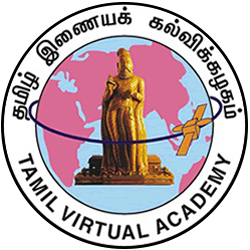Primary tabs
-
Lesson - 1
A04111 Age of Tolkappiar
Tamil language is of very ancient origin as evinced by the history of its literature. Many factors contributed greately to its development. Most noteworthy were a series of councils called Tamil Sangams represented by great exponents and scholars of the language. The first lesson here discusses the ancientness of the language; the role and maxims of the great scholar Agathiar; and the work of the ancient Tamil grammarian called Tholkappiar.
Of about 3000 languages in the world there are about 250 languages that have a written-form. Only a few of them have a combined richness of yore and literature. Tamil is one such classical language like Sanskrit, Greek, Latin, Hebrew and Chinese. While Hebrew, Latin and Sanskrit have ceased to he spoken languages, Tamil continues to shine as the most ancient and the most modern language. It is considered as rich as Greek and Latin in terms of vocabulary and usage. It is the oldest member of the Dravidian Family of Languages, spoken in India even before the Aryan arrival.
The Tamil poets were greatly patronised by the three popular Tamil kings Chola, Chera and Pandya besides a large number of smaller kings. Their creativity was encouraged by awarding many rich gifts. This is clearely documented in sangam literature. Pandyas established three Sangams or councils to develop Tamil as stated in Irayanar Kalaviyal Urai of the eighth century.
Agathiar is a well-known name in the world as a poly-art expert. His work Perakathiyam had 12000 verses describing Tamil.
Tholkappium is the most ancient and the greatest grammatical work in Tamil. Its author Tholkappiar is said to be called so, as he authored this book. It projects the ancient Tamil literary tradition. It has 1610 maxims called Suthirangal. From these we understand that there were many Tamil poets even before his period. He is said to belong to the fifth century B.C. The book has three divisions namely, Ezhuthu, Sol and Porul. This structure was a pioneering work of its kind and it set a precedence for all other succeeding grammarians.
On learning this lesson you will be able to appreciate the ancient nature of Tamil, the greatest contributor called Agathiar and the grammarian of repute, Tholkappiar.


